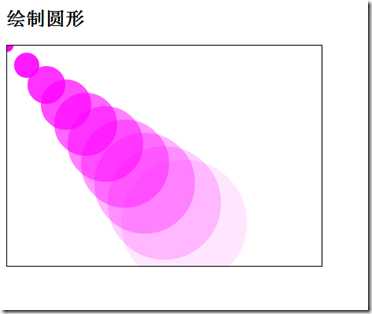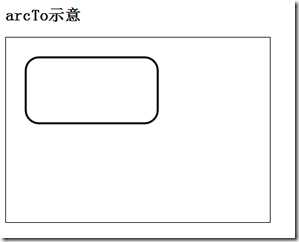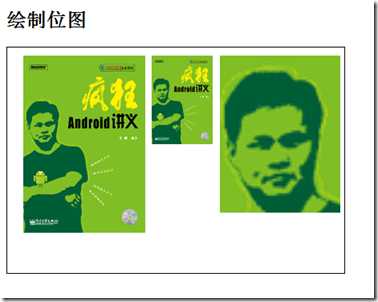标签:
------>使用canvas元素
该元素专门用来绘制图形。但是它元素自身并不绘制图形,它只是相当于一张空画布,只是绘制图形的容器,必须使用JavaScript脚本来绘制图形。
为了向canvas画布上画图,必须经过如下的3个步骤:
1、获取canvas元素对应的DOM对象,这是一个Canvas对象。
2、调用Canvas对象的getContext()方法,该方法返回一个CanvasReaderingContext2D对象,该对象即可绘制图形。
3、调用CanvasReaderingContext2D对象的方法绘图。
<body> <h2>绘图入门</h2> <canvas id="mc" width="300" height="180" style="border:1px solid #000" /> <script type="text/javascript"> //获取canvas元素对应的DOM对象 var canvas = document.getElementById(‘mc‘); //获取在canvas上绘图的CanvasReaderingContent2D var ctx = canvas.getContext(‘2d‘); //设置填充颜色 ctx.fillStyle = ‘#f00‘; //绘制矩形 ctx.fillRect(30,40,80,100); </script> </body>
每个canvas元素对应于一个Canvas对象,Canvas对象的getContext(String contextID)方法将会返回一个绘图API,该方法需要一个字符串参数,目前该方法只支持“2d”字符串作为参数,该方法将会返回一个CanvasReadringContext2D对象。
只提供了两个方法来绘制几何图形:
<body> <h2> 绘制矩形 </h2> <canvas id="mc" width="400" height="280" style="border:1px solid black"></canvas> <script type="text/javascript"> // 获取canvas元素对应的DOM对象 var canvas = document.getElementById(‘mc‘); // 获取在canvas上绘图的CanvasRenderingContext2D对象 var ctx = canvas.getContext(‘2d‘); // 设置填充颜色 ctx.fillStyle = ‘#f00‘; // 填充一个矩形 ctx.fillRect(30 , 20 , 120 , 60); // 设置填充颜色 ctx.fillStyle = ‘#ff0‘; // 填充一个矩形 ctx.fillRect(80 , 60 , 120 , 60); // 设置线条颜色 ctx.strokeStyle = "#00f"; // 设置线条宽度 ctx.lineWidth = 10; // 绘制一个矩形边框 ctx.strokeRect(30 , 130 , 120 , 60); // 设置线条颜色 ctx.strokeStyle = "#0ff"; // 设置线条宽度 ctx.lineJoin = "round"; // 绘制一个矩形边框 ctx.strokeRect(80 , 160 , 120 , 60); // 设置线条颜色 ctx.strokeStyle = "#f0f"; // 设置线条宽度 ctx.lineJoin = "bevel"; // 绘制一个矩形边框 ctx.strokeRect(130 , 190 , 120 , 60); </script> </body>
为了设置绘制字符时所用的字体、字体对其方式,CanvasReadringCOntext2D还提供了如下两个属性: 
<body> <h2> 绘制文字 </h2> <canvas id="mc" width="600" height="280" style="border:1px solid black"></canvas> <script type="text/javascript"> // 获取canvas元素对应的DOM对象 var canvas = document.getElementById(‘mc‘); // 获取在canvas上绘图的CanvasRenderingContext2D对象 var ctx = canvas.getContext(‘2d‘); ctx.fillStyle = ‘#00f‘; ctx.font = ‘italic 50px 隶书‘; ctx.textBaseline = ‘top‘; // 填充字符串 ctx.fillText(‘疯狂Java讲义‘, 0, 0); ctx.strokeStyle = ‘#f0f‘; ctx.font=‘bold 45px 宋体‘; // 绘制字符串的边框 ctx.strokeText(‘轻量级Java EE企业应用实战‘, 0, 50); </script> </body>
<body> <h2> 启用阴影 </h2> <canvas id="mc" width="600" height="280" style="border:1px solid black"></canvas> <script type="text/javascript"> // 获取canvas元素对应的DOM对象 var canvas = document.getElementById(‘mc‘); // 获取在canvas上绘图的CanvasRenderingContext2D对象 var ctx = canvas.getContext(‘2d‘); // 设置阴影的模糊度 ctx.shadowBlur = 5.6; // 设置阴影颜色 ctx.shadowColor = "#222"; // 设置阴影在X、Y方法上的偏移 ctx.shadowOffsetX = 10; ctx.shadowOffsetY = -6; ctx.fillStyle = ‘#00f‘; ctx.font = ‘italic 50px 隶书‘; ctx.textBaseline = ‘top‘; // 填充字符串 ctx.fillText(‘疯狂Java讲义‘, 0, 0); ctx.strokeStyle = ‘#f0f‘; ctx.font=‘bold 45px 宋体‘; // 绘制字符串的边框 ctx.strokeText(‘轻量级Java EE企业应用实战‘, 0, 50); // 填充一个矩形区域 ctx.fillRect(20 , 150 , 180 , 80); ctx.lineWidth = 8; // 绘制一个矩形边框 ctx.strokeRect(300 , 150 , 180 , 80); </script> </body>
为了使用canvas对象绘制更复杂的几何图像,就要使用路径。
<body> <h2> 绘制圆形 </h2> <canvas id="mc" width="400" height="280" style="border:1px solid black"></canvas> <script type="text/javascript"> // 获取canvas元素对应的DOM对象 var canvas = document.getElementById(‘mc‘); // 获取在canvas上绘图的CanvasRenderingContext2D对象 var ctx = canvas.getContext(‘2d‘); for(var i = 0 ; i < 10 ; i++) { // 开始定义路径 ctx.beginPath(); // 添加一段圆弧 ctx.arc(i * 25 , i * 25 , (i + 1) * 8 , 0 , Math.PI * 2 , true); // 关闭路径 ctx.closePath(); // 设置填充颜色 ctx.fillStyle = ‘rgba(255 , 0 , 255 , ‘ + (10 - i) * 0.1 + ‘)‘; // 填充当前路径。 ctx.fill(); } </script> </body>

------>arcto(….)方法与arc(……)方法是有区别的:
该方法也是绘制圆弧。假设从当前点到p1(x1,y1)绘制一条线条,再从p1(x1,y1)到p2(x2,y2)绘制一条线条,arcto方法则绘制一段同时与上面两条线条相切,且半径为radius的圆弧。
------>使用arcto()方法绘制图像:
<body> <h2> arcTo示意 </h2> <canvas id="mc" width="400" height="280" style="border:1px solid black"></canvas> <script type="text/javascript"> /* 该方法负责绘制圆角矩形 x1、y2:是圆角矩形左上角的座标。 width、height:控制圆角举行的宽、高 radius:控制圆角矩形的四个圆角的半径 */ function createRoundRect(context , x1 , y1 , width , height , radius) { // 移动到左上角 ctx.moveTo(x1 + radius , y1); // 添加一条连接到右上角的线段 ctx.lineTo(x1 + width - radius, y1); // 添加一段圆弧 ctx.arcTo(x1 + width , y1, x1 + width, y1 + radius, radius); // 添加一条连接到右下角的线段 ctx.lineTo(x1 + width, y1 + height - radius); // 添加一段圆弧 ctx.arcTo(x1 + width, y1 + height , x1 + width - radius , y1 + height , radius); // 添加一条连接到左下角的线段 ctx.lineTo(x1 + radius, y1 + height); // 添加一段圆弧 ctx.arcTo(x1, y1 + height , x1 , y1 + height - radius , radius); // 添加一条连接到左上角的线段 ctx.lineTo(x1 , y1 + radius); // 添加一段圆弧 ctx.arcTo(x1 , y1 , x1 + radius , y1 , radius); ctx.closePath(); } // 获取canvas元素对应的DOM对象 var canvas = document.getElementById(‘mc‘); // 获取在canvas上绘图的CanvasRenderingContext2D对象 var ctx = canvas.getContext(‘2d‘); ctx.lineWidth = 3; createRoundRect(ctx , 30 , 30 , 200 , 100 , 20); ctx.stroke(); </script> </body>

------->绘制多角星
<body> <h2> lineTo示意 </h2> <canvas id="mc" width="420" height="280" style="border:1px solid black"></canvas> <script type="text/javascript"> /* 该方法负责绘制多角星。 n:该参数通常应设为奇数,控制绘制N角星。 dx、dy:控制N角星的位置。 size:控制N角星的大小 */ function createStar(context , n , dx , dy , size) { // 开始创建路径 context.beginPath(); var dig = Math.PI / n * 4; for(var i = 0; i < n ; i++) { var x = Math.sin(i * dig); var y = Math.cos(i * dig); context.lineTo(x * size + dx ,y * size + dy); } context.closePath(); } // 获取canvas元素对应的DOM对象 var canvas = document.getElementById(‘mc‘); // 获取在canvas上绘图的CanvasRenderingContext2D对象 var ctx = canvas.getContext(‘2d‘); // 绘制3角星 createStar(ctx , 3 , 60 , 60 , 50); ctx.fillStyle = "#f00"; ctx.fill(); // 绘制5角星 createStar(ctx , 5 , 160 , 60 , 50); ctx.fillStyle = "#0f0"; ctx.fill(); // 绘制7角星 createStar(ctx , 7 , 260 , 60 , 50); ctx.fillStyle = "#00f"; ctx.fill(); // 绘制9角星 createStar(ctx , 9 , 360 , 60 , 50); ctx.fillStyle = "#f0f"; ctx.fill(); </script> </body>
CanvasReadringContext2D对象提供了bezierCurveTo()和quadraticCurveTo()两个方法向canvas的当前路径上添加曲线,这两个方法都用于添加曲线,前者用于添加贝济埃曲线,后者用于添加二次曲线。
确定一条贝济埃曲线需要四个点。
<body> <h2> curveTo示意 </h2> <canvas id="mc" width="420" height="280" style="border:1px solid black"></canvas> <script type="text/javascript"> /* 该方法负责绘制花朵。 n:该参数控制花朵的花瓣数。 dx、dy:控制花朵的位置。 size:控制花朵的大小 length:控制花瓣的长度 */ function createFlower(context , n , dx , dy , size , length) { // 开始创建路径 context.beginPath(); context.moveTo(dx , dy + size); var dig = 2 * Math.PI / n; for(var i = 1; i < n + 1 ; i++) { // 结算控制点坐标 var ctrlX = Math.sin((i - 0.5) * dig) * length + dx; var ctrlY= Math.cos((i - 0.5 ) * dig) * length + dy; // 结算结束点的坐标 var x = Math.sin(i * dig) * size + dx; var y = Math.cos(i * dig) * size + dy; // 绘制二次曲线 context.quadraticCurveTo(ctrlX , ctrlY , x , y); } context.closePath(); } // 获取canvas元素对应的DOM对象 var canvas = document.getElementById(‘mc‘); // 获取在canvas上绘图的CanvasRenderingContext2D对象 var ctx = canvas.getContext(‘2d‘); // 绘制5瓣的花朵 createFlower(ctx , 5 , 70 , 100 , 30 , 80); ctx.fillStyle = "#f00"; ctx.fill(); // 绘制6瓣的花朵 createFlower(ctx , 6 , 200 , 100 , 30 , 80); ctx.fillStyle = "#ff0"; ctx.fill(); // 绘制7瓣的花朵 createFlower(ctx , 7 , 330 , 100 , 30 , 80); ctx.fillStyle = "#f0f"; ctx.fill(); </script> </body>
<body> <h2> 绘制位图 </h2> <canvas id="mc" width="420" height="280" style="border:1px solid black"></canvas> <script type="text/javascript"> // 获取canvas元素对应的DOM对象 var canvas = document.getElementById(‘mc‘); // 获取在canvas上绘图的CanvasRenderingContext2D对象 var ctx = canvas.getContext(‘2d‘); // 创建Image对象 var image = new Image(); // 指定Image对象装载图片 image.src = "android.png"; // 当图片装载完成时激发该函数 image.onload = function() { // 保持原大小绘制图片 ctx.drawImage(image , 20 , 10); // 绘制图片时进行缩放 ctx.drawImage(image , 180 , 10 , 76 , 110); var sd = 50; var sh = 65 // 从源位图中挖取一块、放大3倍后绘制在Canvas上 ctx.drawImage(image , 2 , 50 , sd , sh , 265 , 10 , sd * 3 , sh * 3); } </script> </body>

标签:
原文地址:http://www.cnblogs.com/dingchao823/p/4793748.html